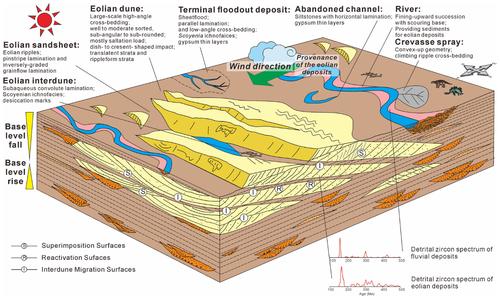当前位置:
X-MOL 学术
›
Basin Res.
›
论文详情
Our official English website, www.x-mol.net, welcomes your
feedback! (Note: you will need to create a separate account there.)
A fluvial-aeolian system in response to aridification during the Late Mesozoic, Junggar Basin, Central Asia
Basin Research ( IF 2.8 ) Pub Date : 2024-06-17 , DOI: 10.1111/bre.12879 Xutong Guan 1 , Chaodong Wu 1 , Yan Xu 1 , Marc Jolivet 2 , Jinlei Xiu 3 , Cong Lin 1
Basin Research ( IF 2.8 ) Pub Date : 2024-06-17 , DOI: 10.1111/bre.12879 Xutong Guan 1 , Chaodong Wu 1 , Yan Xu 1 , Marc Jolivet 2 , Jinlei Xiu 3 , Cong Lin 1
Affiliation

|
Aridification of Central Asia in the Late Mesozoic led to drastic environmental changes characterized by widespread aeolian deposits. We systematically investigated fluvial-aeolian deposits in the Middle Jurassic Toutunhe Formation, Upper Jurassic Kalazha Formation, and Lower Cretaceous Tugulu Group in the Junggar Basin to the north of the Tianshan Orogenic Belt via unmanned aerial vehicle-based photogrammetry, scanning electron microscope, grain-size analysis, and detrital zircon geochronology. Paludal and deltaic environments transitioned to a fluvial-aeolian environment from the late Middle Jurassic to the Late Jurassic. Fan delta and incisive braided river deposits accumulated in the earliest Cretaceous and evolved into a lacustrine environment with aeolian deposits in the lakeshore. Aeolian deposits are characterized by moderate- to well-sorted and subangular to subround sandstones with large-scale, high-dip cross-bedding, inversely graded lamination, dominant saltation grains, crescent-shaped, and dish-shaped impact structures. Aeolian deposits contain heavy minerals including more ilmenite, zircon, garnet, and, tourmaline and less magnetite and epidote than the fluvial deposits. The preserved aeolian sediments of the Kalazha Formation extend west–east for more than 100 km, suggesting a wide desert area during the latest Jurassic. The detrital zircon age patterns indicate that the provenance of the aeolian deposits was similar to that of coeval fluvial deposits. The cooccurrence of fluvial and aeolian deposits and the similar provenances but orthogonal flow directions indicate that the aeolian deposits were mainly sourced from the nearby fluvial material within the basin. The evolution of the fluvial-aeolian system responded to a complete base-level cycle controlled by the aridification and tectonics. Due to decreased sediment supply caused by aridification, the base level rose, leading to the change from braided rivers to meandering rivers, along with the deposition of aeolian sediments. Due to the tectonic reactivation in the Late Jurassic, the base level fell, causing the occurrence of alluvial fans and the expansion of the aeolian sediments. Previous studies revealed that the Tianshan in the Jurassic exhibited low relief. The fluvial-aeolian system played an important role in maintaining the limited relief in southern Central Asia.
中文翻译:

中亚准噶尔盆地晚中生代干旱化的河流-风成系统
中生代晚期的中亚干旱化导致了以广泛的风成沉积物为特征的剧烈环境变化。通过无人机摄影测量、扫描电镜、颗粒物测量等技术,对天山造山带以北准噶尔盆地中侏罗统头屯河组、上侏罗统卡拉扎组、下白垩统吐谷鲁群的河流-风成矿床进行了系统研究。尺寸分析和碎屑锆石地质年代学。从中侏罗世晚期到晚侏罗世,沼泽和三角洲环境转变为河流-风成环境。扇三角洲和尖锐辫状河沉积物在白垩纪早期堆积,并演化为湖岸沉积有风成沉积物的湖泊环境。风成矿床的特点是中度至良分选、次棱角至次圆形砂岩,具有大规模、高倾角交错层理、反级配纹理、跃动粒为主、月牙状、碟状冲击构造等特征。风成矿床含有重矿物,包括比河流沉积物更多的钛铁矿、锆石、石榴石和电气石,以及更少的磁铁矿和绿帘石。保存下来的卡拉扎组风成沉积物从西向东延伸超过100公里,表明侏罗纪末期有广阔的沙漠地区。碎屑锆石年龄模式表明风成矿床的物源与同时代的河流沉积物相似。河流沉积物与风成沉积物共生,物源相似但流向正交,表明风成沉积物主要来源于盆地内附近的河流物质。 河流-风沙系统的演化响应了受干旱化和构造作用控制的完整的基准面旋回。由于干旱化导致泥沙供应减少,基准面上升,导致辫状河向曲流河转变,同时风积沙沉积。由于晚侏罗世构造重新活动,基准面下降,引起冲积扇的出现和风成沉积物的扩张。此前的研究表明,侏罗纪天山呈现出低地势。河流-风成系统对维持中亚南部有限地势发挥了重要作用。
更新日期:2024-06-18
中文翻译:

中亚准噶尔盆地晚中生代干旱化的河流-风成系统
中生代晚期的中亚干旱化导致了以广泛的风成沉积物为特征的剧烈环境变化。通过无人机摄影测量、扫描电镜、颗粒物测量等技术,对天山造山带以北准噶尔盆地中侏罗统头屯河组、上侏罗统卡拉扎组、下白垩统吐谷鲁群的河流-风成矿床进行了系统研究。尺寸分析和碎屑锆石地质年代学。从中侏罗世晚期到晚侏罗世,沼泽和三角洲环境转变为河流-风成环境。扇三角洲和尖锐辫状河沉积物在白垩纪早期堆积,并演化为湖岸沉积有风成沉积物的湖泊环境。风成矿床的特点是中度至良分选、次棱角至次圆形砂岩,具有大规模、高倾角交错层理、反级配纹理、跃动粒为主、月牙状、碟状冲击构造等特征。风成矿床含有重矿物,包括比河流沉积物更多的钛铁矿、锆石、石榴石和电气石,以及更少的磁铁矿和绿帘石。保存下来的卡拉扎组风成沉积物从西向东延伸超过100公里,表明侏罗纪末期有广阔的沙漠地区。碎屑锆石年龄模式表明风成矿床的物源与同时代的河流沉积物相似。河流沉积物与风成沉积物共生,物源相似但流向正交,表明风成沉积物主要来源于盆地内附近的河流物质。 河流-风沙系统的演化响应了受干旱化和构造作用控制的完整的基准面旋回。由于干旱化导致泥沙供应减少,基准面上升,导致辫状河向曲流河转变,同时风积沙沉积。由于晚侏罗世构造重新活动,基准面下降,引起冲积扇的出现和风成沉积物的扩张。此前的研究表明,侏罗纪天山呈现出低地势。河流-风成系统对维持中亚南部有限地势发挥了重要作用。

































 京公网安备 11010802027423号
京公网安备 11010802027423号